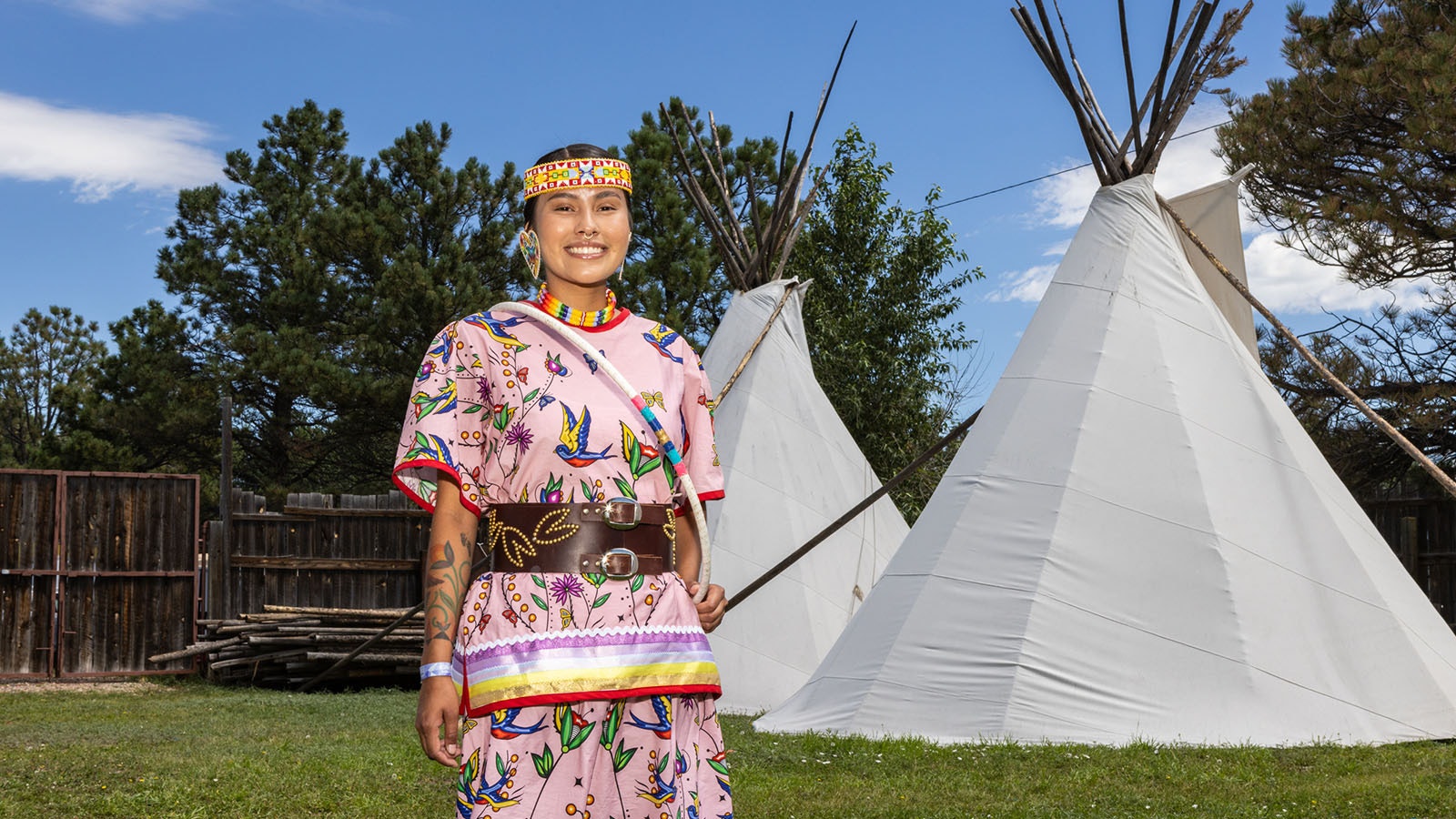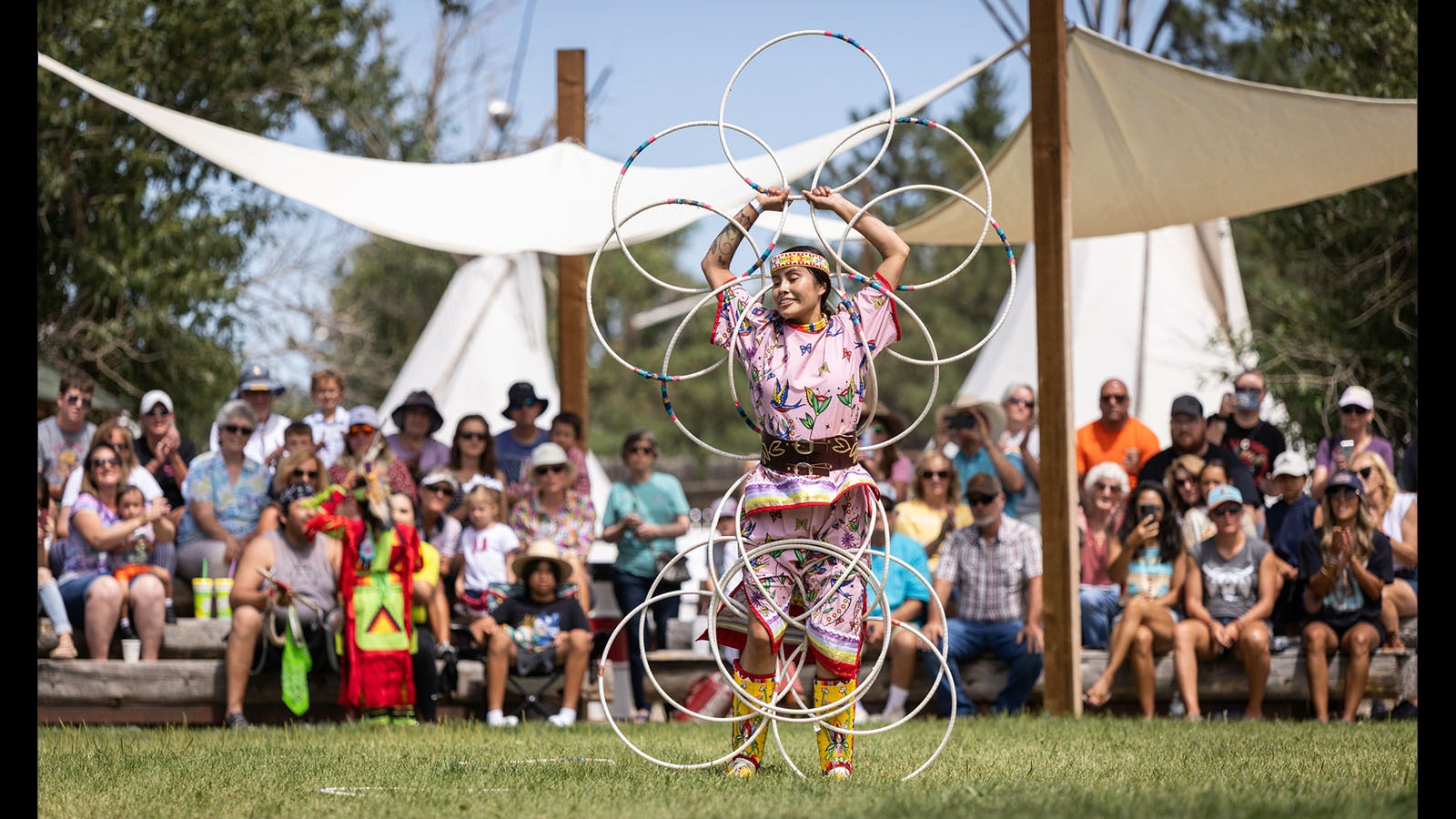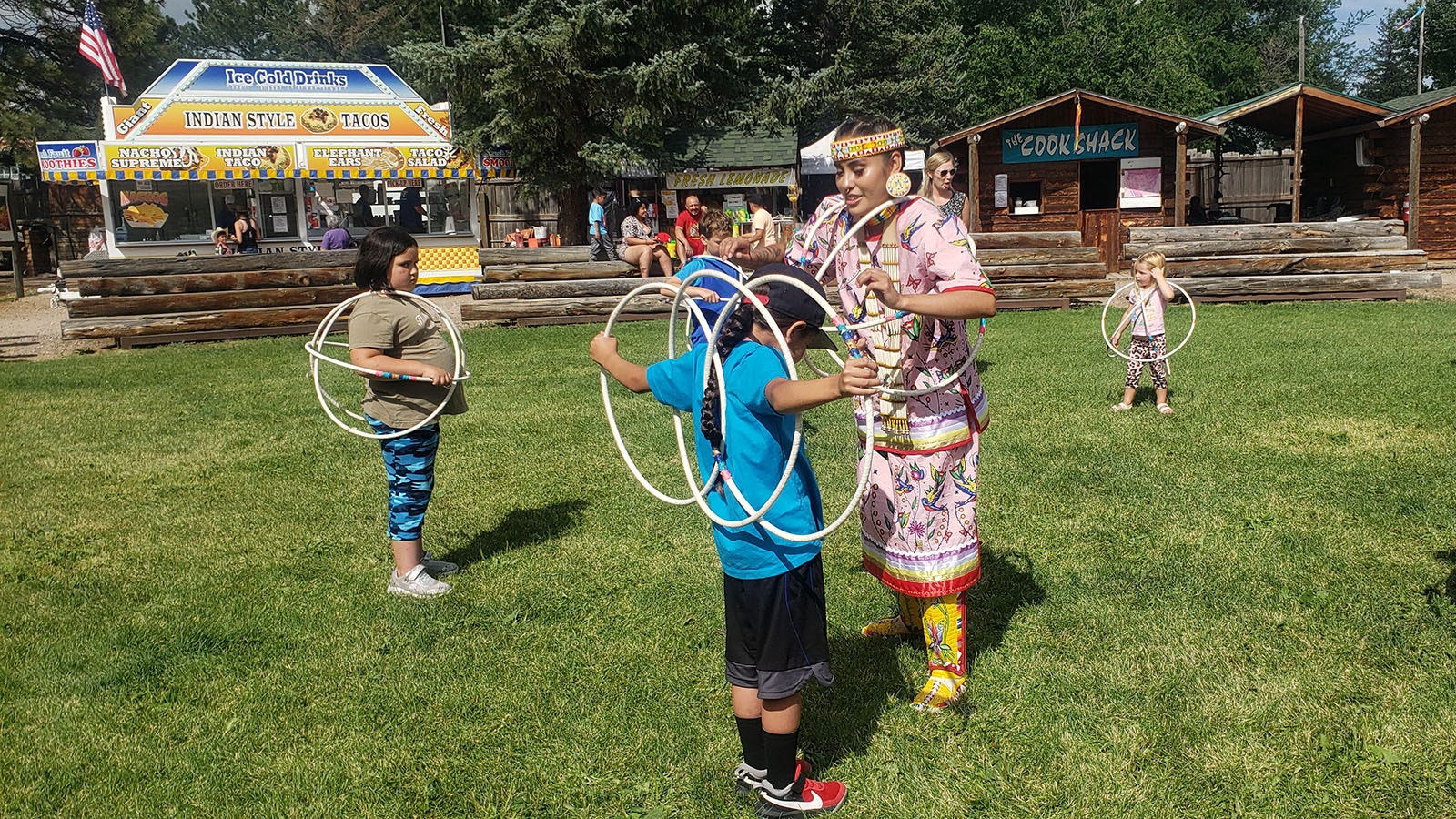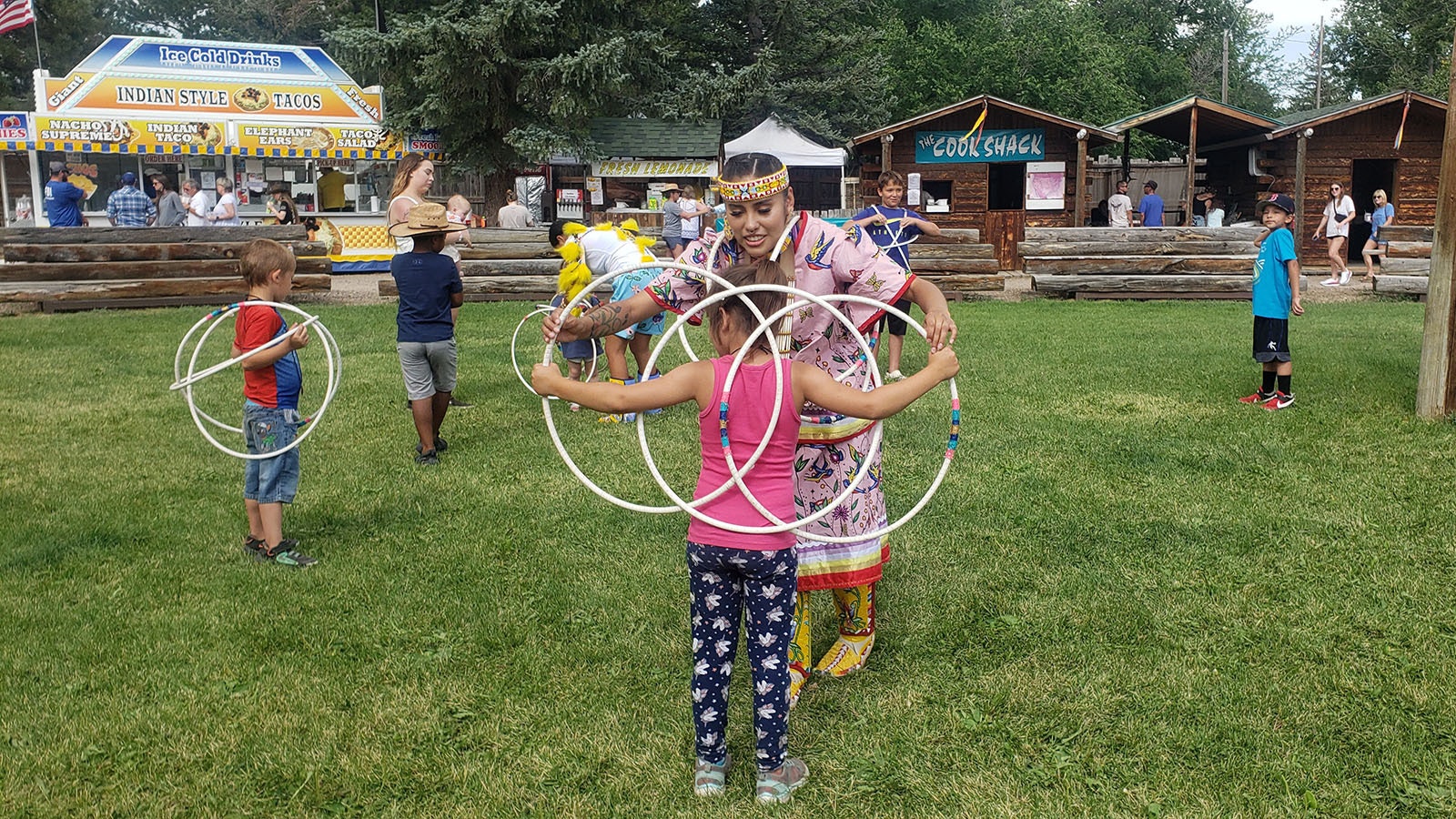Stand anywhere on the earth and put one finger to the horizon line. Follow the direction the finger is pointing to all the way around, back to the beginning. That makes a hoop — a circle of life that follows us from birth until death, no matter where on earth we are.
The hoop dance, one of several Native American dances demonstrated during Cheyenne Frontier Days, honors and celebrates that concept. A circle of life that has no beginning and no end, that each and every one of us carries from birth to death.
The dance has traditionally been dominated by men, but now a new generation of women from many tribes and regions have joined the dance.
Navajo and Arapaho tribal member Zariah June Whiteplume is part of that new generation, and she is the new hoop dancer for the Indian village at Cheyenne Frontier Days, where authentic Native American costumes, dancing, storytelling, flute and drum players, and handicrafts alike are demonstrated.
She performs at 11 a.m., 3 p.m. and 6 p.m. each day of Cheyenne Frontier Days, and is offering a workshop to young children at 4 p.m. as well.
As Cheyenne Frontier Days’ new hoop dancer, Whiteplume is helping carry forward a torch passed to her by a number of teachers, including Jasmine Pickner-Bell, who was the previous Cheyenne Frontier Days hoop dancer.
“Hoop dancing was more of a male-dominated dance when it first originated,” Whiteplume told Cowboy State Daily. “It wasn’t until the late 1980s, into the late 90s, early 2000s when women said, ‘You know, hey, we can do this, too, you know.’”
Pickner-Bell was among the first women to perform this traditional dance in nontraditional attire — a dress. Her aim, she has told reporters in stories about her, was restoring a balance to the circle of life, by bringing back the female aspect.
That balance is important to Whiteplume as well.
“Women are the backbone of the tribe,” Whiteplume said. “So, we can hoop dance, too.”
What Is A Hoop Dance
A hoop dancer stands alone in the dancing field, just them, a blue sky and green grass, and their hoops. They symbolize the circle of life, as well as the many people and connections made along the way.
For many hoop dancers, the dance is a deeply personal and spiritual experience, not just a series of tricks to astonish viewers. It’s meant to be a healing dance that brings blessings not only to the dancer, but to all those seeing it.
Whiteplume has been taught to pick up her hoops with just her feet during the dance. She makes this look smooth and easy, but that is deceptive. Whiteplume has been dancing for 10 years now, ever since she was 9.
As each hoop is picked up, Whiteplume locks them together deftly, twisting them and pulling them around and then outward, making shapes like a butterfly, an eagle, a flower and even a bear.
“I was always told, ‘Take care of your hoops, and they’re going to take care of you,’” Whiteplume said. “’They’ll give you long life and good health.’ And I feel like practicing our traditions as we do, like just how we’re sharing our culture with you guys, that’s bringing not only blessings to you guys, but also blessings for us, as we’re keeping our spirituality alive.”
Whiteplume always explains the hoop dance to the audience before she performs.
“Our formations tell the story of how, you know, the creator, or God, or whoever you believe in, created the world with animals and plants and how it began,” she told Cowboy State Daily.
Flower Favorite
The various shapes Whiteplume creates during the dance are called formations. They can be individual designs that a hoop dancer has devised, but are also often passed down from a teacher to a student.
Whiteplume’s favorite formation, the flower, is among the latter.
“My first teacher, Jasmine, she was the one who taught me how to do the flower,” Whiteplume said. “And I, you know, traditionally, I went up to her and asked her — so traditionally, you’re supposed to offer them some tobacco and bring them a gift.”
After doing that, Whiteplume asked to learn the flower formation.
“So, she gave me the rights to use that,” Whiteplume said. “I was young whenever I learned it, and so she gave me the right to use that information.”
Going Bear
She learned another favorite from her grandfather, Tommy Draper.
“It’s called the bear,” Whiteplume said. “And I have a bunch of hoops on the bottom and some on top, and so the ones on the bottom that stick out of my legs look like bear feet. And then the top, I have to make myself look like a, you know, a bear head with my ears and stuff.”
It’s a fun formation, but challenging.
“It takes all of my hoops,” Whiteplume said. “And then it’s very hard to walk around.”
But it is also well worth the effort, as the crowd clearly loves the formation. There was spontaneous applause as Whiteplume performed it during Cheyenne Frontier Days this year.
The Number Of Hoops Is Significant, Too
Whiteplume uses 21 hoops presently, though she is just 19. The hoops she used during Cheyenne Frontier Days look plain and simple, white, with little decoration.
“Traditionally, this is something I was told, but I don’t know if it’s like for everybody, but some hoop dancers use how many hoops to how old they are,” she said. “So me, I’m going to be 20 this year, but I dance with 21 hoops.”
Whiteplume intends to keep adding hoops as she gets older, keeping that idea in mind, but also according to what she feels ready to do.
“I’m still learning, and there’s still more information that I want to learn how to do,” she said. “And it’s all based on creativity, you know, what you can come up with, with so many little hoops and building into more of the bigger formations.”
Whiteplume started with five hoops.
“I always felt really uncoordinated, you know, especially starting out and I had five hoops,” she said. “I was like, ‘Oh my God, you know, what am I going to do with five hoops?’”
With practice, Whiteplume quickly felt more comfortable, and was able to add many more hoops over time.
She also started going to competitions, and winning awards for her dances. She was a recent competitor at Salt Lake City Utah, during an international hoop dancing contest for women, where she took first place for her dancing, Whiteplume’s grandmother Sandra Ironcloud told Cowboy state Daily.
“She’s done workshops of her own, she did it for the Jumpstart program and Central Wyoming College, and she works with school kids,” Ironcloud said. “For someone as young as she is, you know, we’re really proud of her because she’s made that initiative to be able to go out and be able to share that style of dancing.”

Coming Full Circle
Ironcloud also remembers the first time Whiteplume was at Cheyenne Frontier Days, before she was a hoop dancer.
“I feel like things have come around full circle, because her mom was one of my first dancers,” Ironcloud said. “She was just a baby when she was here, and she’s here helping me now. And I’m really grateful to the teachers who have helped her.”
Sharing the hoop dance at Cheyenne Frontier Days is a special, and spiritual thing, Ironcloud added, but she and Whiteplume both feel it is incredibly important to share and to pass on to a next generation.
“We’re an oral tradition,” Ironcloud said. “We share themes through song and dance, you know, with our families, with our children. Just like with the hoop dance, you know, (Whiteplume’s) mentors have shared with her the style of dancing to pass it on so we don’t lose it, because that is what defines us as Native American people.”
The dances carry forward tribal belief systems and culture through song and dance.
“At one time we were forbidden to speak our language, and that’s where your boarding school era came through,” Ironcloud said. “The important thing is that what we do here is we are carrying on the traditions of our people. Because we are an oral tradition, it’s handed down. The important thing is that this is going to continue to be handed down for those little ones that you’ve seen out there dancing.”
Whiteplumes Vision Of The Future
Sharing Native American culture is also vital to the future of her people, Whiteplume believes.
“People don’t think we still exist,” Whiteplume told Cowboy State Daily. “People can be so ignorant to where they think we still live in teepees. But, you know, throughout the years and generations, you know, us being indigenous people, we had to adapt to these different societies that came along. We had to learn how to get jobs. We had to go out and get an education in order to take care of our families. So, it’s all about adaptation and cultivation.”
Whiteplume wants to take an active role in all of that.
“I want to do this (hoop dancing), get an education, and come back to help my people,” she said. “You know, there’s a lot of issues on the reservation, but I think one that really stands out to me is environmental issues, especially with our water rights, and, you know, our land and allotments and stuff.”
She’s planning to get a minor in environmental science and a major in environmental engineering from a college in North Dakota.
“The younger generation is stepping up, and we need to have more of our own people in those bigger jobs, especially when it comes to engineering, you know, STEM majors, science, technology, engineering, and mathematics. That’s what we need.”
Renée Jean can be reached at renee@cowboystatedaily.com.













